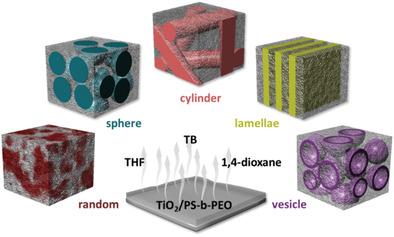当前位置:
X-MOL 学术
›
Small Methods
›
论文详情
Our official English website, www.x-mol.net, welcomes your feedback! (Note: you will need to create a separate account there.)
Key Factors for Template‐Oriented Porous Titania Synthesis: Solvents and Catalysts
Small Methods ( IF 12.4 ) Pub Date : 2020-01-15 , DOI: 10.1002/smtd.201900689 Shanshan Yin 1 , Lin Song 1, 2 , Senlin Xia 1 , Yajun Cheng 3 , Nuri Hohn 1 , Wei Chen 1 , Kun Wang 1 , Wei Cao 1 , Shujin Hou 4 , Peter Müller‐Buschbaum 1, 5
Small Methods ( IF 12.4 ) Pub Date : 2020-01-15 , DOI: 10.1002/smtd.201900689 Shanshan Yin 1 , Lin Song 1, 2 , Senlin Xia 1 , Yajun Cheng 3 , Nuri Hohn 1 , Wei Chen 1 , Kun Wang 1 , Wei Cao 1 , Shujin Hou 4 , Peter Müller‐Buschbaum 1, 5
Affiliation

|
Various types of titania nanostructures are synthesized with a polymer‐templated sol–gel method based on the amphiphilic diblock copolymer polystyrene‐b‐polyethylene oxide (PS‐b‐PEO) in combination with selective incorporation of the titania precursor titanium tetraisopropoxide. Custom tailoring of different types of titania morphologies is realized by changing the phase separation behavior of the PS‐b‐PEO template. Particularly, application of solvents from different categories is found to have a major impact upon the phase separation behavior of PS‐b‐PEO and the final titania film morphology. The amount of available hydrochloric acid catalyst during the gelation process is seen as an additional key factor to induce controllable morphological changes. Scanning electron microscopy and grazing incidence small angle X‐ray scattering measurements are carried out to study the surface and inner structure of porous titania films. Systematic analysis and comparison of different characterization results allow attributing the following three factors to the respectively formed titania nanostructure: the surface energy between PS blocks and surrounding solvent, the aggregation behavior of the titania nanoparticles, and the block‐specific selectivity of the used solvent. For all synthesized titania thin films, an anatase‐type crystallization is confirmed through X‐ray powder diffraction.
中文翻译:

模板导向的多孔二氧化钛合成的关键因素:溶剂和催化剂
基于两亲性二嵌段共聚物聚苯乙烯-b-聚环氧乙烷(PS-b-PEO),结合选择性掺入二氧化钛前体四异丙氧基钛,利用聚合物模板的溶胶-凝胶法合成了各种类型的二氧化钛纳米结构。通过更改PS-b-PEO模板的相分离行为,可以实现对不同类型的二氧化钛形态的定制定制。特别是,发现使用不同类别的溶剂对PS-b-PEO的相分离行为和最终的二氧化钛薄膜形态有重大影响。凝胶化过程中可用盐酸催化剂的量被视为诱导可控形态变化的另一个关键因素。进行了扫描电子显微镜和掠入射小角X射线散射测量,以研究多孔二氧化钛薄膜的表面和内部结构。通过系统分析和比较不同的表征结果,可以将以下三个因素归因于分别形成的二氧化钛纳米结构:PS嵌段与周围溶剂之间的表面能,二氧化钛纳米颗粒的聚集行为以及所用溶剂的嵌段比选择性。对于所有合成的二氧化钛薄膜,通过X射线粉末衍射可确认为锐钛矿型结晶。通过系统分析和比较不同的表征结果,可以将以下三个因素归因于分别形成的二氧化钛纳米结构:PS嵌段与周围溶剂之间的表面能,二氧化钛纳米颗粒的聚集行为以及所用溶剂的嵌段比选择性。对于所有合成的二氧化钛薄膜,通过X射线粉末衍射可确认为锐钛矿型结晶。通过系统分析和比较不同的表征结果,可以将以下三个因素归因于分别形成的二氧化钛纳米结构:PS嵌段与周围溶剂之间的表面能,二氧化钛纳米颗粒的聚集行为以及所用溶剂的嵌段比选择性。对于所有合成的二氧化钛薄膜,通过X射线粉末衍射可确认为锐钛矿型结晶。
更新日期:2020-01-16
中文翻译:

模板导向的多孔二氧化钛合成的关键因素:溶剂和催化剂
基于两亲性二嵌段共聚物聚苯乙烯-b-聚环氧乙烷(PS-b-PEO),结合选择性掺入二氧化钛前体四异丙氧基钛,利用聚合物模板的溶胶-凝胶法合成了各种类型的二氧化钛纳米结构。通过更改PS-b-PEO模板的相分离行为,可以实现对不同类型的二氧化钛形态的定制定制。特别是,发现使用不同类别的溶剂对PS-b-PEO的相分离行为和最终的二氧化钛薄膜形态有重大影响。凝胶化过程中可用盐酸催化剂的量被视为诱导可控形态变化的另一个关键因素。进行了扫描电子显微镜和掠入射小角X射线散射测量,以研究多孔二氧化钛薄膜的表面和内部结构。通过系统分析和比较不同的表征结果,可以将以下三个因素归因于分别形成的二氧化钛纳米结构:PS嵌段与周围溶剂之间的表面能,二氧化钛纳米颗粒的聚集行为以及所用溶剂的嵌段比选择性。对于所有合成的二氧化钛薄膜,通过X射线粉末衍射可确认为锐钛矿型结晶。通过系统分析和比较不同的表征结果,可以将以下三个因素归因于分别形成的二氧化钛纳米结构:PS嵌段与周围溶剂之间的表面能,二氧化钛纳米颗粒的聚集行为以及所用溶剂的嵌段比选择性。对于所有合成的二氧化钛薄膜,通过X射线粉末衍射可确认为锐钛矿型结晶。通过系统分析和比较不同的表征结果,可以将以下三个因素归因于分别形成的二氧化钛纳米结构:PS嵌段与周围溶剂之间的表面能,二氧化钛纳米颗粒的聚集行为以及所用溶剂的嵌段比选择性。对于所有合成的二氧化钛薄膜,通过X射线粉末衍射可确认为锐钛矿型结晶。



























 京公网安备 11010802027423号
京公网安备 11010802027423号